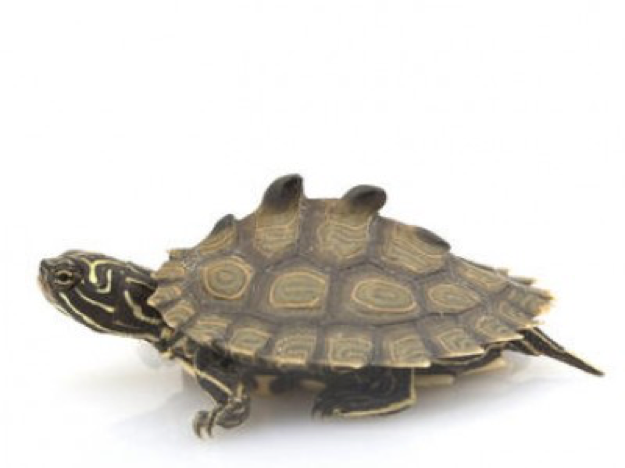
Map Turtle Caresheet
Introduction
There are currently 14 different species of Map turtle. Some of the more common speices kept in captivity in Europe include; The Mississippi Map Turtle (Graptemys pseudogeographica kohni), The False Map Turtle (Graptemys pseudogeographica), The Black Knobbed Map Turtle (Graptemys nigrinoda) and The Ouachita Map Turtle (Graptemys ouachitensis). Map Turtles native range is across North America and their specific range varies depending on the species. Although there are 16 different species of Map turtle their housing and care is quite similar.
Map Turtles have been known to live up to 30 years old and even longer in some cases. The size of Map turtles varies depending on the species but generally females don’t exceed 10 inches in length and males don’t usually grow any longer than 5 inch’s. In the wild, Map turtles are found in creeks, ponds, swamps, marshes, rivers and lakes, and can often be seen basking on logs and rocks or at the edge of a river bank.

Map Turtle Photo
Habitat and Housing
Hatchling Map turtles can be kept in a 2/3 foot long aquarium. Adults however will require a much larger aquarium or ideally a pond. The water depth should be at least twice the width of the turtle’s shell. The water temperature should range between 22-26 degrees Celsius. This can be achieved using an aquarium heater. An underwater hiding place should be provided where the turtle can hide but cannot become trapped and drown.
A basking area is crucial, where the turtle can leave the water completely and fully dry off. The basking area’s temperature should be between 30-35 degrees Celsius. This can be provided by fitting a heat lamp to your aquarium. Map turtles require UVB lighting to survive. UVB provides the turtle with vitamin D3 which then enables the turtle to absorb Calcium from its food. Without Vitamin D3 the turtle will develop metabolic bone disease (MBD) and eventually die. This can be provided by using bulbs which emit UVB which are readily available from any pet shop.
Water quality is very important as the turtles can develop health issues due to inadequate water quality. One way to help ensure good water quality is by using an aquarium or pond filter. External filters are generally more suitable than internal filters as they are larger, and the turtle cannot dislodge the filter causing it to malfunction. Frequent water changes are also necessary to ensure good water quality. Artificial plants, stones and logs should be added to the enclosure to create a more natural look and feel.
Feeding and Diet
Map turtles are omnivorous, so it is important to provide them with both plant and animal matter. Good foods include; fish, worms, insects, leafy greens such as dandelion and aquatic plants such as water hyacinth, water lettuce or duckweed. Furthermore, there is a wide variety of commercial turtle foods available. Hatchling Map turtles require higher levels of protein and calcium in their diet then adults. So, it is important to choose the food which has been formulated to provide optimum nutrition for your turtle’s growth stage. There are a number of vitamins and minerals which are crucial to ensure your turtles healthy development and wellbeing, so it is important to choose a turtle food with a wide range of Vitamins and minerals or add them using a multivitamin and calcium supplement.
It is important not to overfeed your turtle as it will have health implications. Overfeeding in turtles has been shown to cause liver problems, shell deformation and shortened lifespan. Hatchlings should be fed every 2nd day while adults should be fed approximately two times every week.
Map Turtle Health
- Poor water quality can result in your turtle developing skin, shell, and ear infections. Ear infections commonly show up as large bumps behind your turtle's eyes and need to be addressed by your vet.
- Swollen eyes can occur due to a lack of vitamin A in the turtle’s diet. The eyes appear pink and swollen. There are eye drops available but in severe cases a vet should be consulted. The best way to prevent this problem is to provide your turtle with the appropriate diet.
- Metabolic bone disease (MBD) will occur if your turtle isn’t receiving sufficient levels of vitamin D3 and calcium. This will lead to shell deformation, limpness, decreased appetite and if left untreated eventually death. A vet should be consulted if you think your turtle is suffering from MBD.
- Shell Rot can occur if your turtle doesn’t have access to an adequate basking area where it can fully dry off. It causes the shell to literally rot away over time. If left untreated shell rot will gradually get worse. If you think your turtle has shell rot contact your veterinarian.
Sexing and Breeding
Map turtles are sexually dimorphic meaning males and females possess different characteristics other than their sexual organs. Male Map turtles are generally smaller than females and have much longer front claws. Also, their tails are longer than the females. Finally, positioning of the cloaca on a male Map turtle is further down the tail then on a female.
Map turtles begin mating from spring upon emerging from hibernation. The courtship begins when the male and female come face-to-face. The male will stroke the females face and neck with his elongated front claws. The female will then return the gesture. The female will lay her eggs between late May and mid-July. Clutch size varies depending on a number of factors. Larger females lay larger clutches
References and Further reading
Austins Turtle Page. Map Turtle Available at: http://www.austinsturtlepage.com/Care/caresheet-eastern_Map.htm [Accessed 24/07/2019].
Erst, C.H. (2009) Turtles of the United States and Canada. 2nd edition: The Johnsons Hopkins University Press.
Kirkpatrick, D. T. (2006) Aquatic Turtles. 1st Edition: T.F.H Publications.
VANDER SCHOUW, P. Map Turtles. Available at: http://www.reptilesmagazine.com/Care-Sheets/Turtles-Tortoises/Map-Turtle/ [Accessed 24/07/2019].
